Spaghetti Bolognese
Bolognese Sauce: Often served with tagliatelle or other pasta, made with minced meat, tomato sauce, and various vegetables.
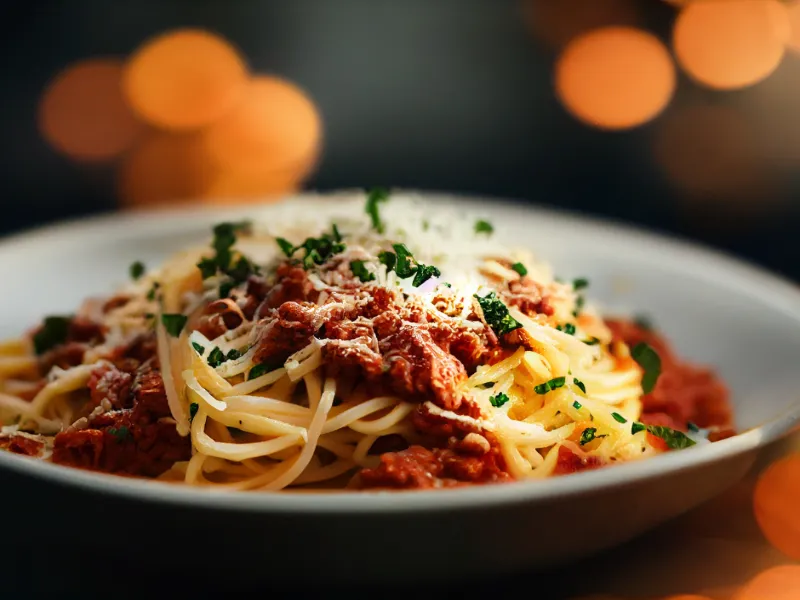
When one thinks of Italian comfort food, Bolognese sauce often comes to mind. It’s a hearty meat sauce that’s become synonymous with Italian culinary tradition. But what makes it so special, and how did it become such a beloved dish? Let’s explore the origins, ingredients, and variations of Bolognese sauce, a dish often served with tagliatelle or other pasta.
The Origins of Bolognese Sauce
Bolognese sauce, or “Ragù alla Bolognese” as it is called in Italian, hails from Bologna, a city known for its rich culinary tradition. The earliest recorded recipe dates back to the late 18th century, and it has since become emblematic of Italian cooking.
Though it has evolved over time, Bolognese sauce’s core ingredients have remained consistent: minced meat, tomatoes, and various vegetables.
Key Ingredients
- The base of a traditional Bolognese sauce starts with a soffritto, a mixture of finely chopped onions, carrots, and celery sautéed in butter or oil. This aromatic blend provides the foundation for the sauce.
- Next comes the minced meat, usually a mix of beef and pork, browned to perfection. Some variations include veal or even pancetta to enhance the flavor.
- Tomatoes are then added to the mix. Some recipes call for fresh tomatoes, while others prefer canned or tomato paste. Regardless of the form, tomatoes give the sauce its characteristic rich and tangy flavor.
- Milk or cream, wine, and a touch of nutmeg may also be included, adding depth and complexity to the taste.
Cooking Process
Bolognese sauce requires a slow and gentle cooking process. After browning the meat and adding the tomatoes and other ingredients, the sauce is left to simmer for several hours. This slow cooking allows the flavors to meld together, creating a harmonious and sumptuous sauce.
Serving Suggestions
Though often associated with spaghetti, authentic Bolognese sauce is typically served with tagliatelle, a flat and broad pasta that perfectly holds the robust sauce. The combination of the sauce with tagliatelle creates “Tagliatelle al Ragù,” a dish celebrated in Bologna.
However, Bolognese sauce’s adaptability has led to its pairing with other types of pasta, such as fettuccine, pappardelle, or even in lasagna.
Variations and Controversies
The popularity of Bolognese sauce has led to countless variations, sparking debates about what constitutes an “authentic” Bolognese. Some purists argue that only certain ingredients and methods should be used, while others embrace the diversity of interpretations.
In 1982, the Italian Academy of Cuisine even recorded an “official” recipe for Bolognese sauce to preserve its traditional form.
Conclusion
Bolognese sauce is more than just a pasta topping; it’s a culinary symbol, representing the warmth and richness of Italian cuisine. Its complex flavors, slow-cooked to perfection, have earned it a beloved spot on tables around the world.
Whether you adhere to a traditional recipe or experiment with your own variations, the essence of Bolognese sauce lies in the quality of ingredients and the love and time poured into its preparation.
A steaming plate of tagliatelle with Bolognese sauce invites you to slow down and savor the moment, a beautiful reminder of Italy’s culinary heritage and the universal joy of sharing a delicious meal.
Carbonara: A Roman pasta dish made with eggs, cheese, pancetta, and pepper.
The Italian culinary landscape is filled with dishes that resonate deeply with both locals and lovers of Italian cuisine worldwide. One such dish is Carbonara, a quintessential Roman pasta that champions simplicity and elegance. Made with merely eggs, cheese, pancetta, and pepper, Carbonara is a study in culinary perfection. Let’s explore this delectable dish’s heritage, preparation, and enduring appeal.
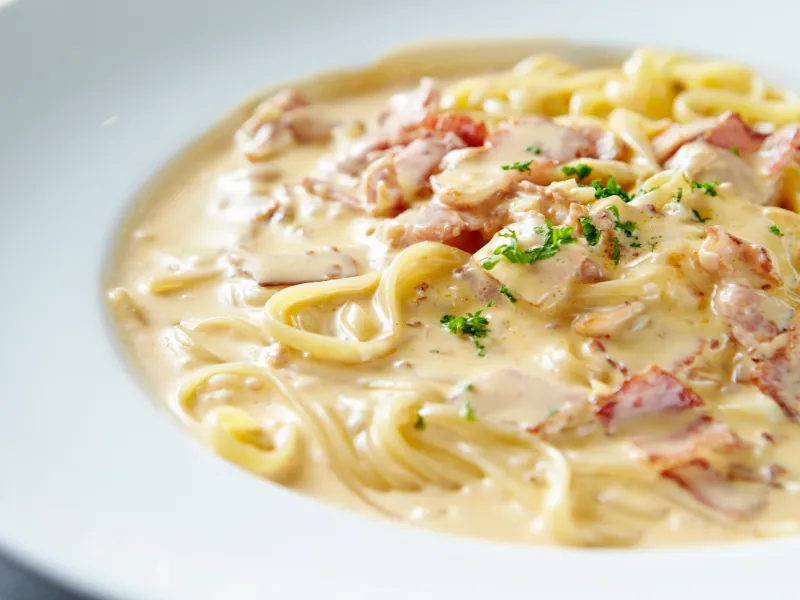
Carbonara’s Roman Roots
The origins of Carbonara are shrouded in mystery, with various legends weaving around its creation. Some say it was a meal for Italian coal miners (carbone means coal in Italian), while others suggest it was influenced by the American soldiers during WWII. Whatever its true origin, Carbonara has become a culinary icon of Rome and has been embraced by Italian food enthusiasts worldwide.
The Simplicity of Ingredients
The brilliance of Carbonara lies in its minimalism. With just four main ingredients, each component shines, contributing to the overall harmony of the dish.
- Eggs: The heart of Carbonara, eggs provide the creaminess without using actual cream. They are typically whisked with cheese to create a lush, velvety sauce.
- Cheese: A combination of Pecorino Romano and Parmigiano-Reggiano gives the dish its salty and nutty edge. Pecorino, made from sheep’s milk, is the traditional choice, offering a sharp tang.
- Pancetta: This Italian cured pork belly adds the necessary saltiness and crunch. Some variations use guanciale, made from pork jowl, which has a more robust flavor.
- Pepper: Freshly cracked black pepper offers a subtle heat, enhancing the other ingredients without overpowering them.
The Art of Cooking Carbonara
Carbonara’s preparation is as simple as its ingredients, but it requires precision and timing. Here’s the typical process:
- Cook the Pasta: Usually spaghetti, though rigatoni or other pasta types can be used.
- Prepare the Sauce: Whisk the eggs with grated cheese and pepper until smooth and creamy.
- Cook the Pancetta: Sauté until crispy but not overcooked.
- Combine: Toss the hot, drained pasta with the pancetta, then quickly add the egg and cheese mixture, stirring vigorously. The heat from the pasta cooks the eggs just enough to create a rich, creamy sauce without scrambling them.
- Season and Serve: Adjust seasoning if needed and serve immediately with additional cheese and pepper.
Carbonara’s Cultural Impact and Variations
Carbonara has transcended its Roman roots to become a global favorite. However, this widespread popularity has led to numerous variations and even controversies. Purists argue that adding ingredients like cream or garlic detracts from the authenticity of the dish.
But like many traditional recipes, Carbonara has been interpreted and reinterpreted by chefs and home cooks alike. Some of these variations have even become beloved in their own right.
Conclusion
Carbonara represents the heart of Italian cooking: high-quality ingredients prepared with skill and passion to create a dish greater than the sum of its parts. Its comforting richness, balanced by salty and peppery notes, has a timeless appeal that connects diners to the eternal city of Rome.
Whether enjoyed in a bustling Roman trattoria or cooked at home for loved ones, Carbonara offers a satisfying and soulful eating experience. It’s a dish that reminds us that sometimes, the simplest ingredients, when treated with respect and expertise, can produce a culinary masterpiece.
Cotoletta alla Milanese: A breaded and fried veal or pork cutlet.
Milan, one of Italy’s most bustling and fashionable cities, is not only known for its contributions to the world of fashion and design but also for its rich culinary tradition. Among its many culinary gems, Cotoletta alla Milanese stands out as a local favorite. This delicious breaded and fried veal or pork cutlet represents the soul of Milanese cuisine, offering a perfect balance of simplicity and indulgence.
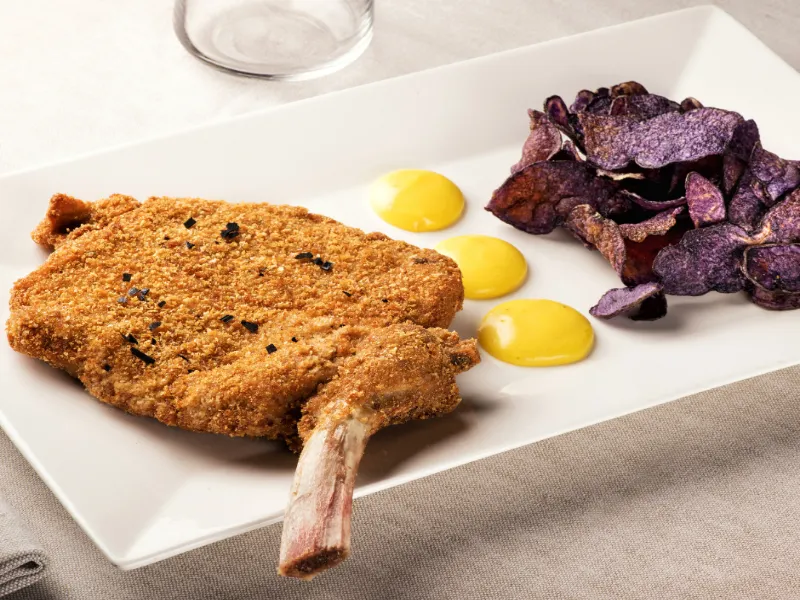
The Historical Essence of Cotoletta alla Milanese
Cotoletta alla Milanese has deep historical roots. Its origin dates back to the 12th century, as recorded in historical documents of a banquet in Milan’s monastery of San Barnaba. Some even argue that it might have inspired the famous Austrian Wiener Schnitzel.
The name “Cotoletta” comes from the Italian word for rib, “costoletta,” referring to the specific cut of meat used in the traditional recipe. Over the centuries, the dish has become synonymous with Milan’s culinary identity.
The Ingredients: Quality Above All
The secret to a perfect Cotoletta alla Milanese lies in the quality of its few, simple ingredients.
- Meat: A bone-in veal chop is the classic choice, though pork is often used as an alternative. The meat must be tender and thick enough to withstand breading and frying.
- Breadcrumbs: Fresh breadcrumbs provide a crispy, golden coating. Seasoning the breadcrumbs adds an extra layer of flavor.
- Eggs: Beaten eggs are used to help the breadcrumbs adhere to the meat, creating that delectable crust.
- Butter: Unlike many other breaded cutlets fried in oil, Cotoletta alla Milanese is traditionally fried in butter, giving it a rich flavor and beautiful golden-brown color.
The Making of Cotoletta alla Milanese
The preparation of Cotoletta alla Milanese is straightforward but requires attention to detail.
- Prepare the Meat: The veal or pork chop is tenderized slightly, keeping its thickness.
- Breading: The meat is dipped in beaten eggs and then coated with seasoned breadcrumbs.
- Frying: The breaded cutlet is fried in butter over medium heat until golden brown on both sides. The butter must be carefully monitored to ensure it doesn’t burn.
- Serving: Traditionally, Cotoletta alla Milanese is served with a lemon wedge and a simple side, such as sautéed spinach or a fresh salad.
Cultural Influence and Modern Interpretations
Cotoletta alla Milanese is more than just a local dish; it’s a cultural symbol of Milan. It’s served everywhere from historic trattorias to modern restaurants.
Contemporary chefs often put their twist on the classic, experimenting with different meats, breadcrumbs, or accompaniments. Whether enjoyed in its most traditional form or with a modern twist, Cotoletta alla Milanese continues to delight palates.
Conclusion: A Taste of Milan
Cotoletta alla Milanese offers a taste of Milan’s history and culinary tradition in each crunchy, buttery bite. Its appeal lies in its simplicity, the quality of its ingredients, and the care taken in its preparation.
For locals, it’s a comforting reminder of home. For travelers, it’s an opportunity to connect with Milan’s culinary heritage. And for anyone who enjoys cooking, it’s a rewarding dish to prepare and savor.
In a world filled with complex flavors and fusion cuisines, Cotoletta alla Milanese stands as a testament to the timeless appeal of a well-cooked, traditional meal. It’s a dish that continues to resonate, bringing a piece of Milan’s vibrant culture to tables around the world.
Fettuccine Alfredo: Pasta served with a rich butter and Parmesan cheese sauce.
Among the pantheon of Italian pasta dishes that have delighted palates across the globe, Fettuccine Alfredo holds a special place. Known for its creamy texture and rich flavor, this classic dish marries fettuccine pasta with a velvety sauce made from butter and Parmesan cheese. Let’s explore the history, preparation, and worldwide love affair with this simple yet scrumptious dish.
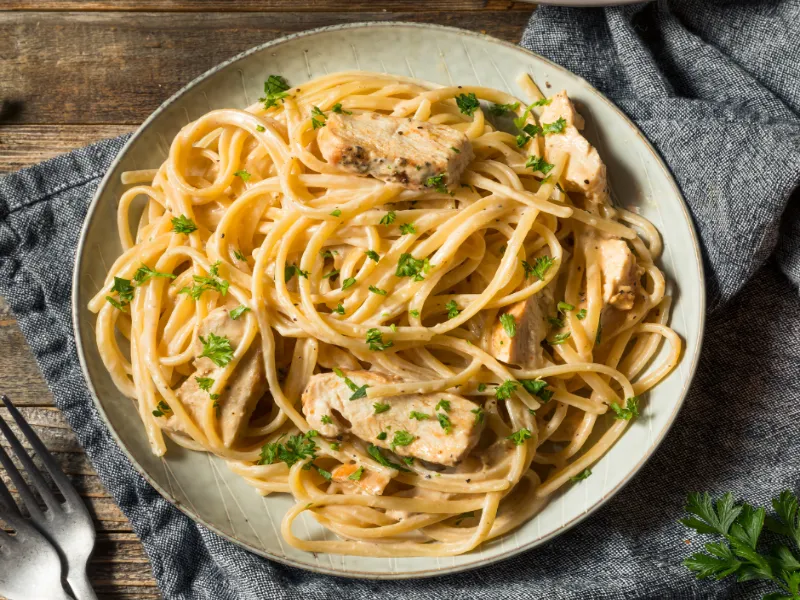
A Dish with a Heartwarming Origin
Unlike many traditional Italian dishes that trace their roots back centuries, Fettuccine Alfredo has a relatively modern origin. It was created in Rome by a restaurateur named Alfredo di Lelio in the early 20th century. Wanting to please his pregnant wife, who had lost her appetite, he prepared a dish using fettuccine pasta tossed with butter and Parmesan cheese. The dish soon became a signature item on his restaurant’s menu, and its fame spread, even reaching Hollywood stars.
The Essence of Simplicity: Ingredients
Fettuccine Alfredo is an ode to simplicity, relying on a few key ingredients to create its indulgent taste:
- Fettuccine: A type of pasta known for its long, flat shape, providing a perfect surface for the sauce to cling to.
- Butter: High-quality unsalted butter contributes richness and a velvety texture.
- Parmesan Cheese: Grated Parmesan adds a nutty, salty depth of flavor, completing the simple yet decadent sauce.
Preparing Fettuccine Alfredo: A Delicate Art
The creation of Fettuccine Alfredo involves a careful interplay between pasta, butter, and cheese:
- Cook the Pasta: Fettuccine is cooked until al dente, preserving a slightly firm texture.
- Create the Sauce: While the pasta cooks, the butter is melted, and the Parmesan cheese is gradually whisked in until smooth and creamy.
- Combine: The cooked pasta is tossed in the butter and cheese sauce, allowing the heat from the pasta to further melt the ingredients and create a rich, clinging coating.
- Serve: The dish is best served immediately, often garnished with a sprinkle of parsley or additional cheese.
A Global Favorite: Interpretations and Variations
Though Fettuccine Alfredo’s core is simplicity, it has inspired countless variations, particularly in international kitchens. In the United States, for instance, cream is often added to create an even richer sauce. Some chefs incorporate garlic, nutmeg, or other herbs for additional flavor.
It’s also common to find versions with added proteins like chicken or shrimp, transforming the dish into a complete meal.
Fettuccine Alfredo’s Enduring Popularity
The appeal of Fettuccine Alfredo lies in its luxurious texture and comforting taste. It’s a dish that has transcended cultural boundaries and can be found in Italian restaurants worldwide. Its popularity is a testament to the power of simple, high-quality ingredients prepared with care and attention.
Conclusion: A Timeless Comfort Food
Fettuccine Alfredo showcases the beauty of Italian cuisine’s ability to turn minimal ingredients into a gastronomic delight. Its success lies not in complexity but in the quality of its components and the skill with which they are blended.
Whether enjoyed in a Roman trattoria or prepared at home for a comforting meal, Fettuccine Alfredo continues to win hearts with its creamy, buttery goodness. It’s more than just a pasta dish; it’s a symbol of culinary creativity and the joy that food can bring to our lives. It stands as a reminder that sometimes, the most memorable meals are those steeped in simplicity and love.
Lasagna: Oven-baked pasta layered with cheese, meat sauce, and béchamel.
Lasagna, the beloved Italian oven-baked dish, has become a symbol of comfort food around the world. Known for its layers of pasta, cheese, meat sauce, and béchamel, lasagna represents Italian cuisine’s rich tapestry of flavors and textures. This dish is more than just a meal; it’s a culinary experience, a family tradition, and a work of art. Let’s explore the fascinating world of lasagna.
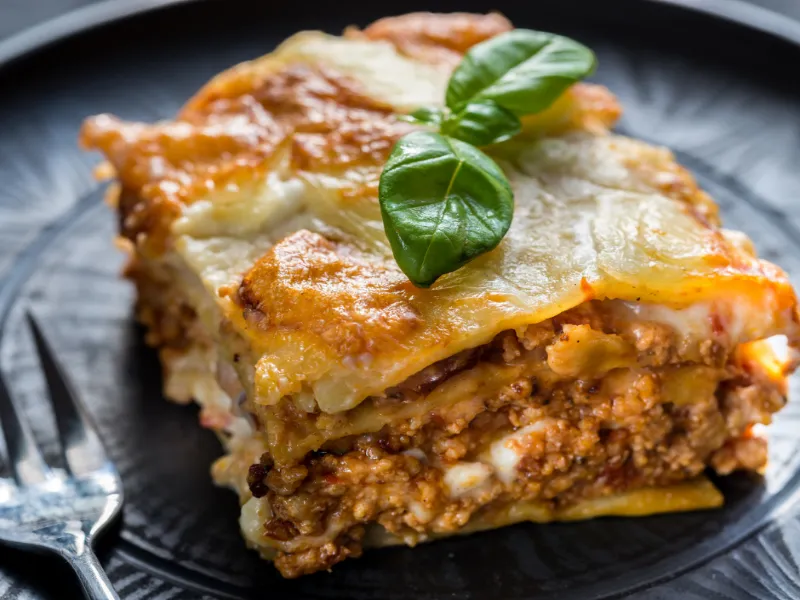
The Origins of Lasagna
Lasagna’s history is a complex layering itself, with roots tracing back to ancient Greece and Rome. The word “lasagna” is believed to derive from the Greek word ‘lásanon,’ referring to a pot or dish. Over time, it has evolved into the sumptuous creation we know today, with various regions in Italy adding their unique touch.
A Masterpiece of Ingredients
What sets lasagna apart is its harmonious blend of multiple components, each vital to the final dish:
- Pasta Sheets: These are the foundation, separating layers and providing structure. Fresh or dried lasagna sheets can be used.
- Meat Sauce: Typically a slow-cooked Bolognese sauce made with minced meat, tomatoes, onions, carrots, and celery.
- Béchamel Sauce: A white sauce made with butter, flour, and milk, adding creaminess to the dish.
- Cheese: Often a combination of Parmesan and mozzarella, giving the lasagna its gooey, melty goodness.
- Herbs: Ingredients like basil, oregano, and thyme can add an aromatic flair to the layers.
Crafting Lasagna: A Step-by-Step Process
Building lasagna is akin to creating a culinary masterpiece, with each layer adding depth and flavor:
- Prepare the Sauces: Cook the meat sauce until rich and flavorful; prepare the béchamel until smooth.
- Boil the Pasta: If using dried pasta sheets, they should be cooked until just tender.
- Layer the Lasagna: Begin with a base layer of meat sauce, followed by pasta sheets, more meat sauce, béchamel, and cheese. Repeat these layers, finishing with béchamel and cheese on top.
- Bake: The lasagna is baked until bubbling and golden, usually around 45 minutes.
- Rest and Serve: Allow the lasagna to rest for a few minutes before slicing to ensure the layers hold together.
Variations and Adaptations
Lasagna has seen countless variations, both within Italy and around the globe:
- Vegetarian Lasagna: Substituting the meat sauce with roasted vegetables or spinach and ricotta.
- Seafood Lasagna: Incorporating seafood like shrimp or crab in a white sauce.
- Regional Variations: Different areas of Italy have their takes on lasagna, such as Lasagna alla Napoletana with sausage and hard-boiled eggs.
Lasagna’s Cultural Impact
Lasagna has transcended its Italian origins to become a beloved dish worldwide. It’s synonymous with family gatherings, holiday celebrations, and cozy dinners. Its complexity in preparation has turned it into a dish often reserved for special occasions, where the labor of love that goes into it can be shared with those closest to us.
Conclusion: Layers of Tradition and Taste
Lasagna embodies the essence of Italian cooking: quality ingredients, careful preparation, and a passion for flavor. It’s a dish that tells a story in each layer, reflecting regional traditions and personal touches.
In a world of fast food and instant meals, lasagna stands as a testament to the joy of slow cooking and the satisfaction derived from creating something truly special from scratch.
Whether served in a family home in Italy or a restaurant across the ocean, lasagna continues to be a dish that connects people. It’s a celebration of taste, culture, and the love that goes into cooking – a true Italian treasure that continues to warm hearts and fill stomachs.
Osso Buco: Braised veal shanks cooked with vegetables, white wine, and broth.
In the world of Italian culinary delights, Osso Buco occupies a cherished place. This rich and flavorful dish, composed of braised veal shanks cooked with vegetables, white wine, and broth, is a testament to the deep culinary traditions that make Italian cuisine so compelling. Let’s embark on a culinary journey to explore Osso Buco, a dish that embodies slow cooking, comfort, and the art of Italian gastronomy.
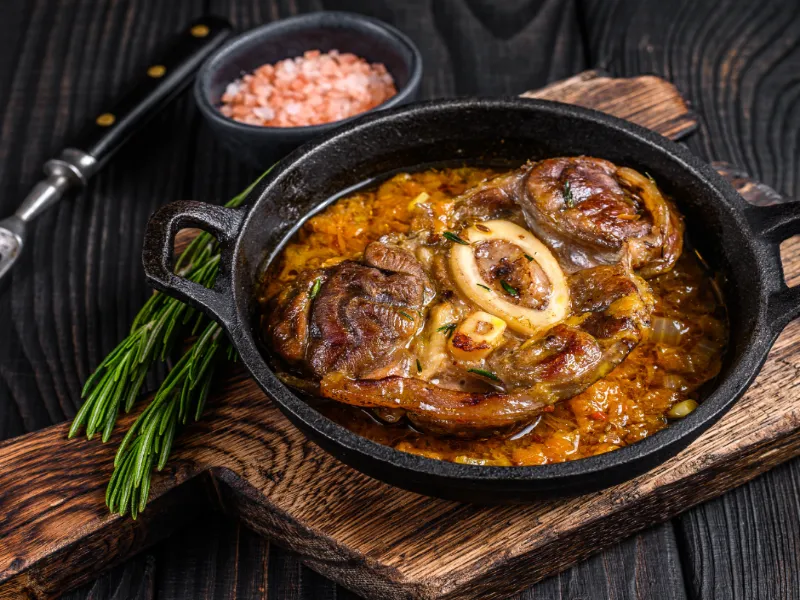
The Name and Origins
“Osso Buco” translates to “bone with a hole,” a reference to the marrow-filled bone in the center of the veal shank. Originating from Milan in the Lombardy region of Italy, Osso Buco is a dish steeped in history, dating back as far as the 18th century. While veal shanks are the traditional choice, variations using pork or beef shanks have also become popular.
The Ingredients: A Symphony of Flavours
Osso Buco’s distinct taste comes from a carefully chosen blend of ingredients:
- Veal Shanks: Thickly cut and often tied to keep their shape during cooking, the shanks are the star of the dish.
- Vegetables: A traditional “soffritto” of onions, carrots, and celery creates a flavorful base.
- White Wine: Adds depth and acidity to the braising liquid.
- Broth: Chicken or beef broth helps to create a rich sauce as the shanks simmer.
- Tomatoes: Some recipes include tomatoes for added color and flavor.
- Herbs and Spices: Thyme, bay leaves, and peppercorns are often used to infuse the dish with aromatic complexity.
Cooking Osso Buco: A Labor of Love
Preparing Osso Buco is a slow and rewarding process:
- Searing the Shanks: The veal shanks are seasoned, dredged in flour, and browned to create a rich crust.
- Building the Base: The vegetables are sautéed, and then wine, broth, and other ingredients are added to form the braising liquid.
- Braising: The shanks are returned to the pot and slow-cooked, often for 1.5 to 2 hours, until tender and infused with flavor.
- Final Touch: Often served with “gremolata,” a mix of lemon zest, garlic, and parsley sprinkled on top just before serving.
Serving Osso Buco: A Culinary Experience
Osso Buco is typically served over a bed of creamy risotto, polenta, or mashed potatoes, allowing the side dish to soak up the flavorful sauce. The marrow inside the bone is a prized delicacy, often scooped out and enjoyed with the meat.
Osso Buco’s Cultural Significance
Osso Buco is more than a dish; it’s an expression of Italian culture and a celebration of slow-cooked goodness. It’s a staple in trattorias and family kitchens alike, especially during winter months when its warmth and depth of flavor are most appreciated.
Variations and Modern Takes
Modern chefs have explored new variations of Osso Buco, playing with different types of meat, wine, or herbs, and sometimes adding a touch of cream to the sauce. These creative interpretations pay homage to the classic while expanding its culinary horizons.
Conclusion: A Dish that Warms the Soul
Osso Buco embodies the principles of Italian cooking: respect for tradition, quality ingredients, and the joy of sharing a lovingly prepared meal with friends and family. Its deep flavors, succulent meat, and rich sauce are a culinary embrace, providing comfort and satisfaction in every bite.
Whether enjoyed in a rustic Italian countryside kitchen or a chic urban restaurant, Osso Buco is a timeless dish that continues to captivate food enthusiasts. It is a celebration of Italian heritage, a delicious journey through layers of taste, and a reminder of the profound pleasures found in a well-cooked meal.
Pesto alla Genovese: Pasta with a sauce made of basil, pine nuts, garlic, Parmesan cheese, and olive oil.
Imagine a sauce so vibrant and flavorful that it encapsulates the essence of summer in every bite. Pesto alla Genovese, a tantalizing blend of fresh basil, pine nuts, garlic, Parmesan cheese, and olive oil, does just that. This delightful sauce hails from Genoa, Italy, and has become synonymous with the Ligurian region’s culinary heritage. Let’s explore this verdant gem of Italian cuisine.
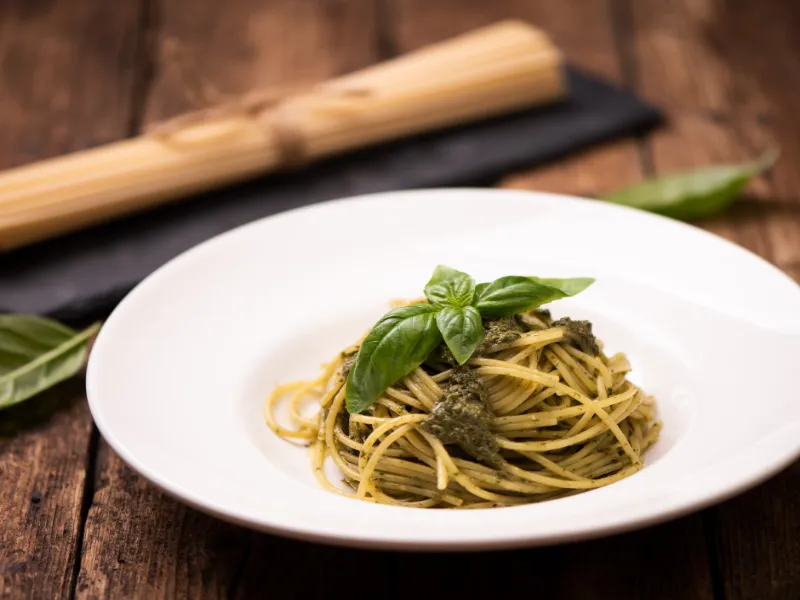
The Origins and History
Pesto alla Genovese has its roots in the picturesque region of Liguria, where the mild climate and fertile soil create the perfect conditions for basil cultivation. The name “pesto” comes from the Italian word “pestare,” which means to crush or pound, a reference to the traditional method of preparation using a mortar and pestle.
Ingredients: A Palette of Flavors
Pesto alla Genovese is a study in simplicity, relying on just a few high-quality ingredients:
- Basil: Fresh, bright green basil leaves are the heart and soul of the sauce.
- Pine Nuts: These add a subtle, buttery richness to the texture.
- Garlic: Just a clove or two infuses the pesto with a gentle pungency.
- Parmesan Cheese: This cheese lends a savory depth to balance the fresh flavors.
- Olive Oil: Extra virgin olive oil binds the ingredients and adds a smooth, velvety texture.
- Salt: A pinch of salt enhances the individual flavors.
Creating Pesto alla Genovese: An Artful Process
The preparation of Pesto alla Genovese is a sensory delight:
- Pound the Basil: Traditionally, basil leaves are gently pounded with a mortar and pestle to release their oils.
- Add the Nuts and Garlic: Pine nuts and garlic are added and crushed into the basil.
- Incorporate the Cheese: Grated Parmesan cheese is mixed in, followed by a steady drizzle of olive oil.
- Adjust to Taste: The pesto is seasoned and adjusted to achieve the perfect balance of flavors.
- Toss with Pasta: Pesto alla Genovese is often served with pasta, such as trofie or linguine, and sometimes potatoes and green beans.
The Impact and Influence of Pesto
Pesto alla Genovese has transcended its regional origins to become a beloved sauce globally. Its fresh, herbal notes and rich texture have inspired variations using different herbs, nuts, and cheeses. However, purists argue that nothing compares to the classic version made with Ligurian basil.
Pesto’s Versatility: Beyond Pasta
While most commonly paired with pasta, Pesto alla Genovese’s vibrant flavor profile lends itself to various culinary applications. It can be spread on bruschetta, drizzled over grilled vegetables, used as a marinade for meats, or stirred into soups.
Conclusion: A Celebration of Freshness
Pesto alla Genovese is more than a sauce; it’s a celebration of the Italian reverence for fresh, quality ingredients. Its creation is a culinary ritual that pays homage to traditional techniques and the bounty of the Ligurian landscape.
Whether enjoyed in a seaside trattoria in Genoa or a bustling city kitchen miles away, Pesto alla Genovese has a way of transporting the diner to a sun-kissed Italian garden filled with the scent of blooming basil.
It’s a sauce that speaks of passion, tradition, and the joy of savoring simple pleasures. Pesto alla Genovese is not just a taste of summer; it’s a taste of Italy’s enduring love affair with food and the bonds it creates around the dinner table. It’s a culinary masterpiece, vibrant and timeless, waiting to be discovered in every delightful forkful.
Risotto alla Milanese: A saffron-infused risotto often served as a main course.
Golden-hued, creamy, and decadent, Risotto alla Milanese is one of Italy’s most iconic dishes. Originating from Milan, the capital of Lombardy, this saffron-infused risotto is a delightful expression of Italian culinary artistry. Often served as a main course, Risotto alla Milanese has garnered admiration and love from food enthusiasts worldwide. Let’s delve into the world of this rich and flavorful dish.
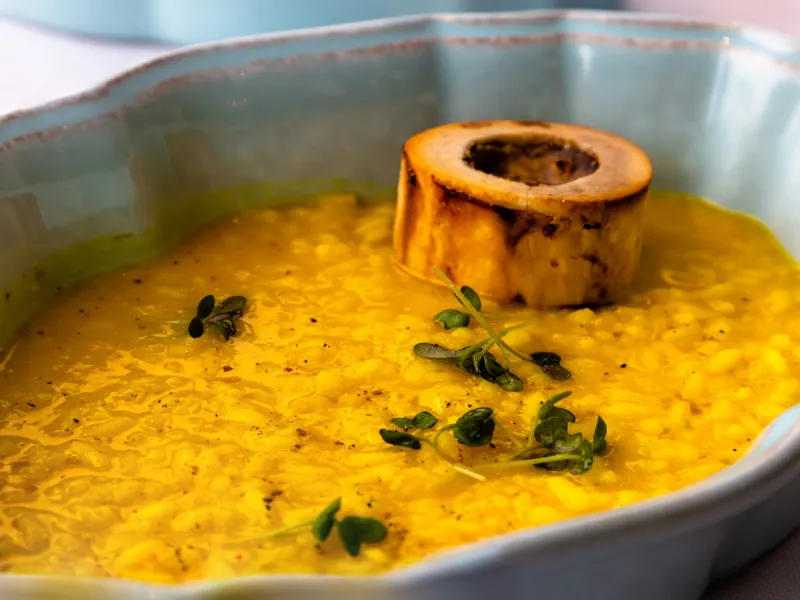
A Glimpse into the Origins
The history of Risotto alla Milanese dates back to the 16th century, and like many classic dishes, its origin is adorned with legend. Some say that a young apprentice who was working on the stained glass windows of Milan’s Cathedral added saffron to a wedding feast’s rice dish to mimic the color of the glass. The result was so extraordinary that it became a culinary sensation.
The Core Ingredients: Simplicity at Its Best
Risotto alla Milanese is built on a foundation of simplicity, relying on just a few quality ingredients to create a masterpiece:
- Arborio Rice: This short-grain rice is prized for its ability to absorb liquid and develop a creamy texture without losing its shape.
- Saffron: The star of the dish, saffron lends its distinctive golden color and subtle flavor.
- Onions: Finely chopped onions form the aromatic base.
- White Wine: Adds acidity and depth to the flavor profile.
- Broth: Chicken or beef broth, simmered with saffron threads, creates the cooking liquid.
- Butter and Parmesan: For a rich and velvety finish.
Crafting Risotto alla Milanese: A Dance of Patience and Technique
Preparing Risotto alla Milanese is an exercise in patience, requiring constant attention and gentle stirring:
- Sauté Onions: Cook onions in butter until translucent.
- Toast the Rice: Add the rice, stirring to coat the grains with butter and lightly toast.
- Deglaze with Wine: Add white wine, cooking until it’s mostly evaporated.
- Cook with Saffron-infused Broth: Gradually add hot saffron-infused broth, stirring and allowing the rice to absorb the liquid before adding more.
- Finish with Richness: Once the rice is cooked to a creamy consistency, stir in additional butter and Parmesan cheese.
- Serving Tradition: Risotto alla Milanese as a Main Course
- Risotto alla Milanese can be enjoyed as a luxurious main course or served alongside ossobuco or other meat dishes. The vibrant golden color and rich, creamy texture make it a standout dish on any table.
Variations and Contemporary Takes
Modern chefs have experimented with Risotto alla Milanese, introducing ingredients like seafood or vegetables. Some have even played with alternative grains or spices, paying homage to the classic while adding a personal twist.
The Cultural Impact of Risotto alla Milanese
This dish is more than a regional specialty; it’s a culinary icon. It symbolizes Milan’s culinary heritage, reflecting the elegance and sophistication that the city is known for. The use of saffron, one of the world’s most precious spices, underscores its status as a dish to be savored and celebrated.
Conclusion: A Rich Tapestry of Flavor
Risotto alla Milanese is an ode to the beauty of Italian cooking, where time, quality ingredients, and skilled craftsmanship converge to create something extraordinary. It’s a dish that transcends mere sustenance, offering a rich and satisfying culinary experience.
Whether enjoyed in a grand Milanese restaurant or a cozy home kitchen, Risotto alla Milanese continues to enchant with its delicate balance of flavors, luxurious texture, and the sheer joy of a meal crafted with love.
It’s not just a risotto; it’s a golden thread that connects us to a rich culinary tradition, a piece of Milan’s soul served on a plate. Risotto alla Milanese is, indeed, a feast for both the eyes and the palate, a timeless treasure in the world of Italian cuisine.
Saltimbocca: Veal, prosciutto, and sage, usually cooked with white wine.
Saltimbocca is a delightful dish that embodies the zest and creativity of Italian cooking. Consisting of tender veal, salty prosciutto, aromatic sage, and often enhanced with a splash of white wine, Saltimbocca is a culinary marvel that excites the taste buds and offers a satisfying glimpse into Italy’s rich culinary heritage.

The Name and Origins
The name “Saltimbocca” translates from Italian as “jumps in the mouth,” and with one taste, it’s easy to see why. This dish, whose origins are often attributed to Rome, offers an explosion of flavors that indeed seem to leap into the mouth.
The Classic Ingredients: A Trio of Perfection
The charm of Saltimbocca lies in its simplicity and the quality of its ingredients:
- Veal: Thinly sliced veal escalopes form the tender base of the dish.
- Prosciutto: This thinly sliced, cured ham adds a savory and salty dimension.
- Sage: Fresh sage leaves provide a hint of earthy, aromatic freshness.
- White Wine: Often used in cooking, white wine lends acidity and complexity to the sauce.
Crafting Saltimbocca: A Quick and Elegant Process
Preparing Saltimbocca is a straightforward yet refined process:
- Prepare the Veal: The veal slices are pounded thin and then topped with prosciutto and a sage leaf. They are often secured with a toothpick.
- Cook to Perfection: The veal is pan-fried quickly in butter or oil, often just a minute or two on each side until lightly browned.
- Create the Sauce: After removing the veal, white wine, and sometimes chicken stock, is added to the pan to deglaze, creating a simple yet flavorful sauce.
- Serve Immediately: Saltimbocca is typically served hot, drizzled with the pan sauce, and accompanied by vegetables or potatoes.
The Sensory Experience: A Harmonious Balance
Saltimbocca offers a sensory experience like few others. The tender texture of the veal, the salty richness of the prosciutto, the fragrant aroma of the sage, and the tangy brightness of the white wine sauce come together in perfect harmony. It’s a dish that manages to be both comforting and sophisticated.
Variations: An Invitation to Experiment
While the classic Roman Saltimbocca is widely acclaimed, variations exist across Italy and beyond. Some recipes use chicken or pork instead of veal, while others introduce additional herbs or even cheese. These adaptations are a testament to Saltimbocca’s enduring appeal and versatility.
Serving Saltimbocca: An Elegant Main Course
Saltimbocca makes an elegant main course, suitable for a simple family dinner or a festive occasion. The quick cooking time and minimal preparation make it an ideal choice for hosts seeking to impress without spending hours in the kitchen.
Conclusion: A Dish to Savor and Celebrate
Saltimbocca is a culinary gem that showcases the art of Italian cooking in a beautiful, accessible manner. It’s a dish that invites us to appreciate the quality of ingredients and the joy of a meal prepared with care and passion.
In every bite of Saltimbocca, we find a reflection of Italy’s culinary soul – unpretentious yet sophisticated, traditional yet open to innovation. It’s a dish that not only “jumps in the mouth” but also leaps into the heart, leaving a lasting impression of warmth and delight.
Whether you are exploring it for the first time in a quaint Roman trattoria or recreating it in your kitchen, Saltimbocca offers a flavorful journey into Italian culture and gastronomy. Its elegance, taste, and simplicity continue to inspire food lovers, reinforcing its status as a timeless favorite in Italian cuisine.
Spaghetti alla Puttanesca: A tangy and slightly salty Italian pasta dish made with tomatoes, olives, capers, and garlic.
Spaghetti alla Puttanesca is one of those dishes that you simply can’t forget. Its bold and unapologetic flavors are a love letter to Italian cuisine’s robust, hearty side. This tangy and slightly salty pasta dish, brimming with tomatoes, olives, capers, garlic, and sometimes anchovies, is more than just a meal—it’s an experience.
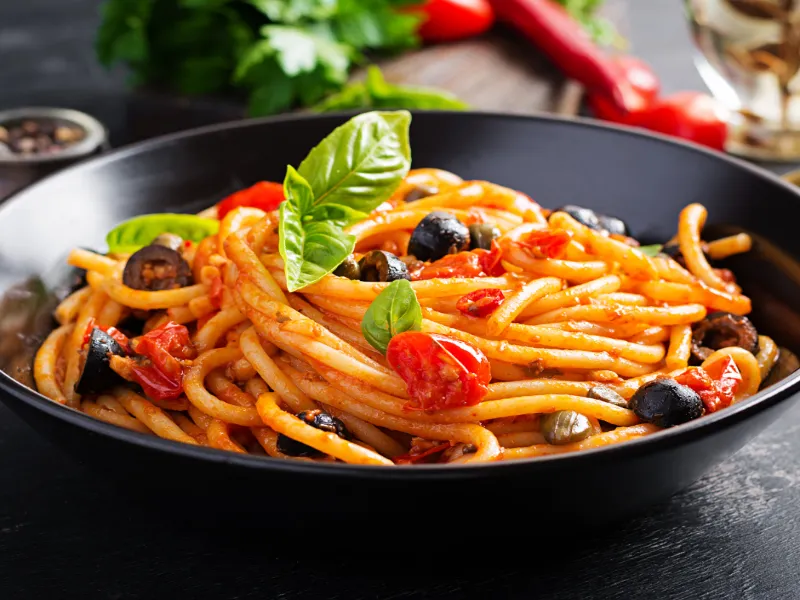
A Name with a Story
The origins of Spaghetti alla Puttanesca are as colorful as the dish itself. With “puttanesca” translating to “in the style of a prostitute” in Italian, there are various theories as to how the dish got its name. Some say it was quickly made with whatever ingredients were on hand, while others believe the strong aroma lured customers. Whatever the true story, Spaghetti alla Puttanesca has certainly made a name for itself.
The Ingredients: A Palette of Bold Flavours
Spaghetti alla Puttanesca is built on a foundation of readily available ingredients, each contributing a distinct character to the dish:
- Tomatoes: Fresh or canned tomatoes create the tangy and robust sauce base.
- Olives: Typically black olives, they add a savory bite.
- Capers: These small flower buds lend a unique salty and briny flavor.
- Garlic: Essential for depth and aroma.
- Anchovies: Optional, but when included, they offer an underlying umami complexity.
- Chili Flakes: For those who prefer a spicy kick.
- Spaghetti: The perfect vessel to carry all these intense flavors.
Crafting the Dish: A Simple Yet Vibrant Process
The joy of Spaghetti alla Puttanesca is in its simplicity and quick preparation:
- Sauté Garlic: Start with gently sautéing garlic (and anchovies, if using) in olive oil.
- Build the Sauce: Add the tomatoes, olives, capers, and chili flakes, simmering to meld the flavors.
- Cook the Pasta: Simultaneously, cook the spaghetti until al dente.
- Combine: Toss the spaghetti in the sauce, coating every strand.
- Serve: Finish with a sprinkle of fresh parsley or basil and enjoy hot.
The Experience: A Dish That Demands Attention
The first bite of Spaghetti alla Puttanesca is a wake-up call to the palate. The mingling of tart tomatoes, salty capers, briny olives, and the subtle heat of chili creates an unforgettable flavor profile. It’s a dish that doesn’t shy away from its identity, proudly presenting bold and assertive flavors.
Puttanesca Across Italy: Regional Variations
While most common in the Campania region, Spaghetti alla Puttanesca has found its way across Italy and into the hearts of many. Variations might include different types of pasta or additional ingredients like bell peppers or fresh tuna. However, the soul of the dish—the robust and tangy sauce—remains constant.
Conclusion: A Celebration of Italian Gusto
Spaghetti alla Puttanesca is a reflection of Italian cuisine’s ability to transform humble ingredients into something extraordinary. It’s a dish that celebrates gusto, both in flavor and in the sheer enjoyment of eating.
Whether enjoyed in a bustling Neapolitan eatery or made at home for a comforting meal, Spaghetti alla Puttanesca serves up authenticity, passion, and a touch of Italian flair.
It’s more than a pasta dish; it’s an invitation to embrace the lively and generous spirit of Italian cooking. It’s a plate full of personality, history, and above all, deliciousness—a true testament to the enduring appeal of Italy’s culinary tradition.


